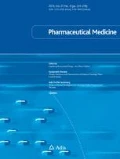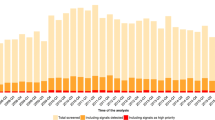Abstract
Background
The US Food and Drug Administration’s Sentinel System was established to monitor safety of regulated medical products. Sentinel investigators identified known associations between drugs and adverse events to test reusable analytic tools developed for Sentinel. This test case used a comparator with a different indication.
Objective
We tested the ability of Sentinel’s reusable analytic tools to identify the known association between warfarin and gastrointestinal bleeding (GIB). Statins, expected to have no effect on GIB, were the comparator. We further explored the impact of analytic features, including matching ratio and stratifying Cox regression analyses, on matched pairs.
Methods
This evaluation included data from 14 Sentinel Data Partners. New users of warfarin and statins, aged 18 years and older, who had not received other anticoagulants or had recent GIB were matched on propensity score using 1:1 and 1:n variable ratio matching, matching statin users with warfarin users to estimate the average treatment effect in warfarin-treated patients. We compared the risk of GIB using Cox proportional hazards regression, following patients for the duration of their observed continuous treatment or until a GIB. For the 1:1 matched cohort, we conducted analyses with and without stratification on matched pair. The variable ratio matched cohort analysis was stratified on the matched set.
Results
We identified 141,398 new users of warfarin and 2,275,694 new users of statins. In analyses stratified on matched pair/set, the hazard ratios (HR) for GIB in warfarin users compared with statin users were 2.78 (95% confidence interval [CI] 2.36–3.28) in the 1:1 matched cohort and 3.10 (95% CI 2.76–3.49) in the variable ratio matched cohort. The HR was lower in the analysis of the 1:1 matched cohort not stratified by matched pair (2.22, 95% CI 1.97–2.49), and highest early in treatment. Follow-up for warfarin users tended to be shorter than for statin users.
Conclusions
This study identified the expected GIB risk with warfarin compared with statins using an analytic tool developed for Sentinel. Our findings suggest that comparators with different indications may be useful in surveillance in select circumstances. Finally, in the presence of differential censoring, stratification by matched pair may reduce the potential for bias in Cox regression analyses.


Similar content being viewed by others
References
Platt R, Wilson M, Chan KA, Benner JS, Marchibroda J, McClellan M. The new Sentinel Network: improving the evidence of medical-product safety. N Engl J Med. 2009;361(7):645–7.
Platt R, Brown JS, Robb M, et al. The FDA Sentinel Initiative: an Evolving National Resource. N Engl J Med. 2018;379(22):2091–3.
Sentinel Distributed Database and Common Data Model. Available at: https://www.sentinelinitiative.org/sentinel/data/distributed-database-common-data-model. Accessed 19 Nov 2018.
Sentinel surveillance tools, routine querying system. Available at: https://www.sentinelinitiative.org/sentinel/surveillance-tools/routine-querying-tools/routine-querying-system. Accessed 12 Mar 2018.
Gagne JJ, Han X, Hennessy S, et al. Successful comparison of US food and drug administration sentinel analysis tools to traditional approaches in quantifying a known drug-adverse event association. Clin Pharmacol Ther. 2016;100(5):558–64.
Zhou M, Wang SV, Leonard CE, et al. Sentinel modular program for propensity-score matched cohort analyses: application to glyburide, glipizide, and serious hypoglycemia. Epidemiology. 2017;28(6):838–46.
Carnahan RM, Kuntz JL, Wang SV, et al. Evaluation of the US Food and Drug Administration sentinel analysis tools in confirming previously observed drug-outcome associations: the case of clindamycin and Clostridium difficile infection. Pharmacoepidemiol Drug Saf. 2018;27(7):731–9.
Iowa Health Fact Book: Alzheimer’s Disease Mortality. Available at: http://iowahealthfactbook.org/factbook/#/aspects/data/Other%20Mortality/Alzheimer’s%20Disease%20Mortality/0. Accessed 24 Jan 2018.
Schulman S, Beyth RJ, Kearon C, Levine MN. Hemorrhagic complications of anticoagulant and thrombolytic treatment: American College of Chest Physicians Evidence-Based Clinical Practice Guidelines (8th Edition). Chest. 2008;133(6 Suppl):257s–98s.
Johnsen SP, Sorensen HT, Mellemkjoer L, et al. Hospitalisation for upper gastrointestinal bleeding associated with use of oral anticoagulants. Thromb Haemost. 2001;86(2):563–8.
Assiri A, Al-Majzoub O, Kanaan AO, Donovan JL, Silva M. Mixed treatment comparison meta-analysis of aspirin, warfarin, and new anticoagulants for stroke prevention in patients with nonvalvular atrial fibrillation. Clin Ther. 2013;35(7):967–984.e962.
Setoguchi S, Glynn RJ, Avorn J, Mogun H, Schneeweiss S. Statins and the risk of lung, breast, and colorectal cancer in the elderly. Circulation. 2007;115(1):27–33.
Curtis JR, Delzell E, Chen L, et al. The relationship between bisphosphonate adherence and fracture: is it the behavior or the medication? Results from the placebo arm of the fracture intervention trial. J Bone Miner Res. 2011;26(4):683–8.
Shrank WH, Patrick AR, Brookhart MA. Healthy user and related biases in observational studies of preventive interventions: a primer for physicians. J Gen Intern Med. 2011;26(5):546–50.
Lund JL, Richardson DB, Sturmer T. The active comparator, new user study design in pharmacoepidemiology: historical foundations and contemporary application. Curr Epidemiol Rep. 2015;2(4):221–8.
Gulmez SE, Lassen AT, Aalykke C, et al. Do statins protect against upper gastrointestinal bleeding? Br J Clin Pharmacol. 2009;67(4):460–5.
Hackam DG, Woodward M, Newby LK, et al. Statins and intracerebral hemorrhage: collaborative systematic review and meta-analysis. Circulation. 2011;124(20):2233–42.
Badillo R, Schmidt R, Mortensen EM, Frei CR, Mansi I. Statin therapy and gastrointestinal hemorrhage: a retrospective cohort study with propensity score-matching. Pharmacoepidemiol Drug Saf. 2015;24(8):849–57.
van Rein N, Cannegieter SC, le Cessie S, et al. Statins and risk of bleeding: an analysis to evaluate possible bias due to prevalent users and healthy user aspects. Am J Epidemiol. 2016;183(10):930–6.
Huitfeldt A, Hernan MA, Kalager M, Robins JM. Comparative effectiveness research using observational data: active comparators to emulate target trials with inactive comparators. EGEMS (Wash DC). 2016;4(1):1234.
Leonard CE, Brensinger CM, Bilker WB, et al. Gastrointestinal bleeding and intracranial hemorrhage in concomitant users of warfarin and antihyperlipidemics. Int J Cardiol. 2017;228:761–70.
Brazauskas R, Logan BR. Observational studies: matching or regression? Biol Blood Marrow Transpl. 2016;22(3):557–63.
Cummings P, McKnight B, Greenland S. Matched cohort methods for injury research. Epidemiol Rev. 2003;25:43–50.
Sutradhar R, Baxter NN, Austin PC. Terminating observation within matched pairs of subjects in a matched cohort analysis: a Monte Carlo simulation study. Stat Med. 2016;35(2):294–304.
Schelleman H, Bilker WB, Brensinger CM, Wan F, Yang YX, Hennessy S. Fibrate/Statin initiation in warfarin users and gastrointestinal bleeding risk. Am J Med. 2010;123(2):151–7.
Schelleman H, Brensinger CM, Bilker WB, Hennessy S. Antidepressant-warfarin interaction and associated gastrointestinal bleeding risk in a case-control study. PLoS One. 2011;6(6):e21447.
Cunningham A, Stein CM, Chung CP, Daugherty JR, Smalley WE, Ray WA. An automated database case definition for serious bleeding related to oral anticoagulant use. Pharmacoepidemiol Drug Saf. 2011;20(6):560–6.
Nakasian SS, Rassen JA, Franklin JM. Effects of expanding the look-back period to all available data in the assessment of covariates. Pharmacoepidemiol Drug Saf. 2017;26(8):890–9.
Kerlin MP, Tokar JL. Acute gastrointestinal bleeding. Ann Intern Med. 2013;159(11):793–4.
Tielleman T, Bujanda D, Cryer B. Epidemiology and Risk Factors for Upper Gastrointestinal Bleeding. Gastrointest Endosc Clin N Am. 2015;25(3):415–28.
Patrick AR, Schneeweiss S, Brookhart MA, et al. The implications of propensity score variable selection strategies in pharmacoepidemiology: an empirical illustration. Pharmacoepidemiol Drug Saf. 2011;20(6):551–9.
Myers JA, Rassen JA, Gagne JJ, et al. Effects of adjusting for instrumental variables on bias and precision of effect estimates. Am J Epidemiol. 2011;174(11):1213–22.
Normand ST, Landrum MB, Guadagnoli E, et al. Validating recommendations for coronary angiography following acute myocardial infarction in the elderly: a matched analysis using propensity scores. J Clin Epidemiol. 2001;54(4):387–98.
Austin PC. An introduction to propensity score methods for reducing the effects of confounding in observational studies. Multivar Behav Res. 2011;46(3):399–424.
Rassen JA, Glynn RJ, Rothman KJ, Setoguchi S, Schneeweiss S. Applying propensity scores estimated in a full cohort to adjust for confounding in subgroup analyses. Pharmacoepidemiol Drug Saf. 2012;21(7):697–709.
Rassen JA, Shelat AA, Myers J, Glynn RJ, Rothman KJ, Schneeweiss S. One-to-many propensity score matching in cohort studies. Pharmacoepidemiol Drug Saf. 2012;21(Suppl 2):69–80.
Binswanger I, Blatchford P, Smiley-Mcdonald H, Ellis C. NDI-DCRP data linking task final report. 2014.
Austin PC. The performance of different propensity score methods for estimating marginal hazard ratios. Stat Med. 2013;32(16):2837–49.
McMahan DA, Smith DM, Carey MA, Zhou XH. Risk of major hemorrhage for outpatients treated with warfarin. J Gen Intern Med. 1998;13(5):311–6.
Copland M, Walker ID, Tait RC. Oral anticoagulation and hemorrhagic complications in an elderly population with atrial fibrillation. Arch Intern Med. 2001;161(17):2125–8.
Zuccaro G. Epidemiology of lower gastrointestinal bleeding. Best Pract Res Clin Gastroenterol. 2008;22(2):225–32.
McGraw D, Rosati K, Evans B. A policy framework for public health uses of electronic health data. Pharmacoepidemiol Drug Saf. 2012;21(Suppl 1):18–22.
Forrow S, Campion DM, Herrinton LJ, et al. The organizational structure and governing principles of the Food and Drug Administration’s Mini-Sentinel pilot program. Pharmacoepidemiol Drug Saf. 2012;21(Suppl 1):12–7.
Gagne JJ, Glynn RJ, Avorn J, Levin R, Schneeweiss S. A combined comorbidity score predicted mortality in elderly patients better than existing scores. J Clin Epidemiol. 2011;64(7):749–59.
Schneeweiss S, Seeger JD, Maclure M, Wang PS, Avorn J, Glynn RJ. Performance of comorbidity scores to control for confounding in epidemiologic studies using claims data. Am J Epidemiol. 2001;154(9):854–64.
Acknowledgements
The authors would like to thank Patrick Archdeacon, MD, for his contributions in planning the study, and Zilu Zhang, MS, for assistance with analyses. The authors would also like to gratefully acknowledge the contributions of the following organizations that provided data used in the analysis: Aetna, Blue Bell, PA; Blue Cross Blue Shield of Massachusetts, Boston, MA; Harvard Pilgrim Health Care Institute, Boston, MA; HealthCore, Inc., Translational Research for Affordability and Quality, Alexandria, VA; HealthPartners Institute (formerly Health Partners Research Foundation), Minneapolis, MN; Humana, Inc., Comprehensive Health Insights, Miramar, FL; Kaiser Permanente Colorado Institute for Health Research, Denver, CO; Kaiser Permanente Center for Health Research Hawai’i, Honolulu, HI; Kaiser Permanente Mid-Atlantic States, Mid-Atlantic Permanente Research Institute, Rockville, MD; Kaiser Permanente Northern California, Division of Research, Oakland, CA; Kaiser Permanente Northwest Center for Health Research, Portland, OR; Kaiser Permanente Washington Health Research Institute (formerly Group Health Research Institute), Seattle, WA; Marshfield Clinic Research Institute, Marshfield, WI; Meyers Primary Care Institute, Worcester, MA; OptumInsight Life Sciences Inc., Boston, MA; Vanderbilt University Medical Center, Department of Health Policy, Nashville, TN, which is indebted to the Tennessee Division of TennCare of the Department of Finance and Administration, which provided data.
Author information
Authors and Affiliations
Corresponding author
Ethics declarations
Funding
The Sentinel System is sponsored by the US FDA and funded by the FDA through the Department of Health and Human Services (HHS) Contract Number HHSF223201400030I. This study was supported under Mini-Sentinel Contract Numbers HHSF223200910006I/HHSF22301008T.
Conflicts of Interest
Ryan Carnahan, Joshua Gagne, Charles Leonard, Sengwee Toh, Candace Fuller, Sean Hennessy, Laura Hou, Noelle Cocoros, Genna Panucci, Tiffany Woodworth, Austin Cosgrove, Aarthi Iyer, and Elizabeth Chrischilles report no conflicts of interest. Christian Hampp works for the FDA, which funded the study.
Ethics Approval
Sentinel has been deemed a public health activity under the auspices of the FDA and not under the purview of Institutional Review Boards [42, 43].
Additional information
The results of this query have been posted on the Sentinel Initiative website with minimal context or interpretation.
Electronic supplementary material
Below is the link to the electronic supplementary material.
Rights and permissions
About this article
Cite this article
Carnahan, R.M., Gagne, J.J., Hampp, C. et al. Evaluation of the US Food and Drug Administration Sentinel Analysis Tools Using a Comparator with a Different Indication: Comparing the Rates of Gastrointestinal Bleeding in Warfarin and Statin Users. Pharm Med 33, 29–43 (2019). https://doi.org/10.1007/s40290-018-00265-w
Published:
Issue Date:
DOI: https://doi.org/10.1007/s40290-018-00265-w




